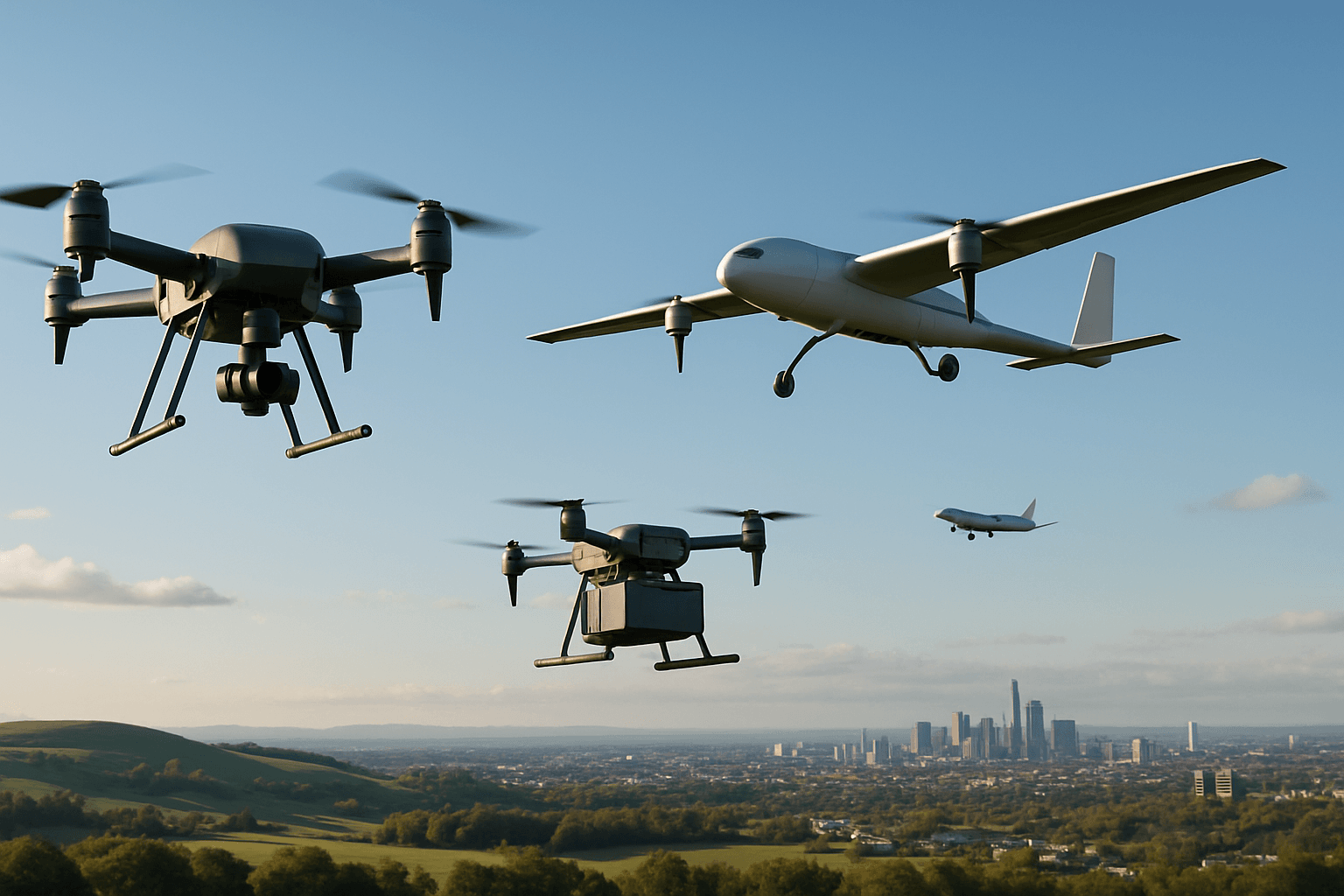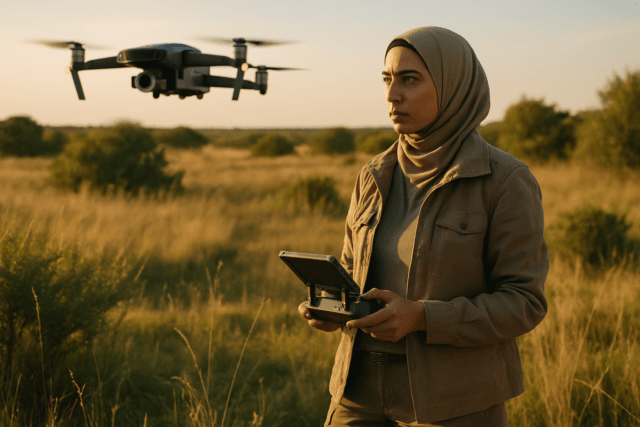The UK Civil Aviation Authority (CAA) is paving the way for widespread Unmanned Aircraft System (UAS) deployment, aiming to integrate drones into the nation’s airspace by 2027. This ambitious plan seeks to unlock the economic and social benefits of drone technology, making beyond visual line of sight (BVLOS) operations a routine aspect of aviation across the UK.
UK’s Drone Revolution: A Flight Path to 2027
The CAA’s vision involves a phased approach, focusing on safety, technological advancements, and regulatory changes to accommodate the growing UAS sector.
Key Objectives
The CAA’s UAS program is structured around three core areas:
- Safety: Ensuring the safe integration of UAS into the UK’s total aviation system.
- Efficiency and Effectiveness: Creating an enabling regulatory environment that fosters innovation and aligns with international standards.
- Support the UK Government’s Drone Strategy: Promoting the safe use of drones and encouraging industry best practices.
Regulatory Framework
The operation of UAS in the UK is governed by two primary legislative frameworks:
- UK Regulation (EU) 2018/1139: This regulation covers aspects such as registration requirements for civil UAS.
- The Air Navigation Order 2016: Amended by the Civil Aviation Act 1982, this order addresses various aspects of aviation safety and regulation.
The CAA’s Role
The CAA plays a crucial role in regulating aviation within the UK, operating within a legislative framework set by the government and overseen by the Department for Transport. Its responsibilities include:
- Setting safety and operational standards for civil UAS.
- Influencing international developments in UAS procedures and regulations.
- Promoting safety to the public and engaging with the industry.
- Investigating technical mitigation options and recommending implementation.
Charting the Course: Key Steps to UAS Integration
The CAA has outlined several key steps to achieve widespread UAS deployment by 2027:
Technology and Regulatory Changes
- BVLOS Operations: Enabling BVLOS operations is crucial for unlocking the full potential of drone technology. This requires overcoming challenges related to safety, regulation, and technology.
- Detect-and-Avoid (DAA) Technology: Implementing DAA technologies is essential for safe integration of UAS into non-segregated airspace. The CAA envisions a “technical and operational solution” using DAA to mitigate the risk of mid-air collisions.
- Electronic Conspicuity: Utilizing technologies like ADS-B to enhance the visibility of UAS to other airspace users.
- Air Traffic Management (ATM) Integration: Integrating UAS into existing ATM systems to ensure safe and efficient airspace management.
- Pilot Training and Certification: Introducing new certification levels for remote pilots to support a wider range of operational scenarios.
- Specific Operation Risk Assessment (SORA): Implementing SORA from 2025 to assess and mitigate risks associated with UAS operations.
Phased Approach
The CAA’s roadmap follows a three-phased approach:
- Demonstrate: Conducting initial demonstration efforts to inform the development of routine operations.
- Scale: Expanding operations to enable routine BVLOS flights.
- Sustain: Establishing a sustainable framework for widespread UAS deployment.
Workstreams
The CAA has identified four primary workstreams to support UAS integration:
- Operational Authorizations: Streamlining the process for obtaining necessary approvals.
- Vehicle Flightworthiness: Assessing and validating the safety of UAS designs and operations.
- Pilot Competency: Ensuring that remote pilots have the necessary skills and knowledge.
- Airspace Integration: Developing procedures and technologies for safe airspace sharing.
These workstreams are built on foundation elements of environmental impact, safety, physical security, and cybersecurity.
Overcoming Challenges and Embracing Opportunities
Integrating UAS into the UK’s airspace presents several challenges, including:
- Regulatory hurdles: Navigating the complex regulatory landscape and obtaining necessary authorizations.
- Technical limitations: Developing and implementing reliable DAA systems and communication technologies.
- Public perception: Addressing concerns about safety, privacy, and noise pollution.
Despite these challenges, the potential benefits of widespread UAS deployment are significant:
- Economic growth: The UK drone market is projected to reach £1.2 billion by 2025, making it the fastest-growing drone market in Europe.
- Improved public services: Drones can enhance emergency response, infrastructure inspection, and delivery services.
- Environmental benefits: Drones can reduce carbon emissions and improve environmental monitoring.
- Societal benefits: UAS technology offers solutions for various applications, from agriculture and construction to surveillance and search and rescue.
Regulations and Legalities
The CAA has established regulations for drone operations, with key requirements including:
- Registration: Operators of drones with cameras must register with the CAA and obtain an Operator ID.
- Flyer ID: Pilots must obtain a Flyer ID by passing an online theory test.
- Altitude Limit: Drones cannot fly above 400 feet (120 meters).
- Visual Line of Sight (VLOS): Drones must be operated within visual line of sight, unless authorized for BVLOS operations.
- No-Fly Zones: Drones are prohibited from flying near airports or airfields.
- Labeling: Drones must be labeled with the operator ID.
Open Category
For pilots flying under the Open Category rules, these requirements apply:
- The drone’s maximum take-off mass must be less than 25kg.
- The drone must be kept within Visual Line of Sight (VLOS).
- Flights must not exceed 400 ft (120 meters) from the earth’s surface.
UAS Operator Radio Licence
Ofcom issues UAS Operator Radio Licenses, which authorize the use of radio equipment on drones for command and control, including mobile and satellite terminals, and safety systems.
Atypical Air Environments (AAE)
The Civil Aviation Authority introduced a policy in October 2024 to enable BVLOS flights in Atypical Air Environments (AAE). These are areas with reduced conventional air traffic due to proximity to ground infrastructure and enhance safety while unlocking BVLOS applications for routine tasks such as powerline inspections, wind turbine maintenance, and site security.
Innovations and Projects
Several projects and initiatives are underway to advance UAS technology and integration in the UK:
- Future Flight Challenge: A £300 million program funding projects that advance drone capabilities.
- Project XCelerate: Demonstrating the feasibility of BVLOS for logistics and public services.
- Skyway Project: Developing a 165-mile drone superhighway connecting airspace above major cities.
Drone Superhighway
The UK’s first drone superhighway, developed by Altitude Angel, is set to open, creating a 165-mile network between Coventry and Milton Keynes. This system uses 30 Arrow Towers to manage drone traffic from the ground.
Government Support
The UK government is investing heavily in drone technology:
- Over £20 million in funding to launch new flight technologies.
- £16.5 million to the CAA to deliver a regulatory program for BVLOS operations and air taxis.
- £273 million government investment in the aerospace sector.
The Future of Flight
The CAA’s plan represents a significant step towards integrating drones into the UK’s airspace, promising a future where UAS technology enhances various aspects of life and drives economic growth. By addressing safety concerns, fostering innovation, and establishing clear regulatory frameworks, the UK is positioning itself as a leader in the global drone revolution.





